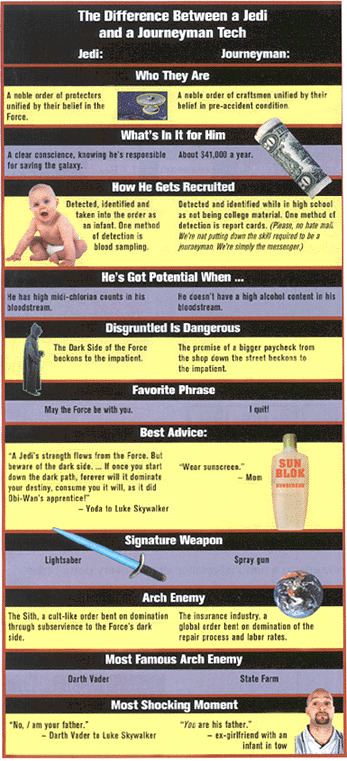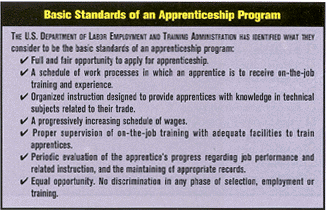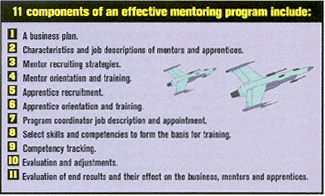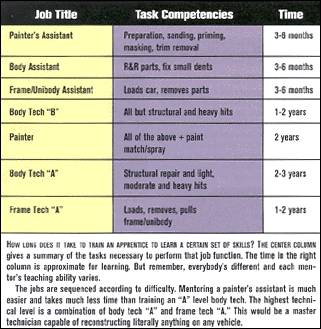During the time of the Galactic Civil War, Jedi were nearly extinct. Though Jedi candidates were normally taken into the order as infants, desperate times called for desperate measures. Two Jedi survivors, Obi-Wan Kenobi and Jedi Master Yoda, took Luke Skywalker into the fold, despite the fact that Skywalker was well past the traditional age requirements (he was already an adult when he picked up his first lightsaber). But by using the Jedi form of training – the apprentice/mentor method – they managed to train Skywalker, the first new Jedi in a generation.
This apprentice/mentor method works well in the real world too. And it’s been around just as long as the battle between good and evil.
In ancient Greece, young boys were paired with older, experienced men in the hope that each boy would learn and emulate the values of the experienced men. The boys were taught basic survival skills, culture and values from these men, whom they admired.
The method later evolved as young boys were paired with a master in his trade who owned a shop or business. The boy lived with the master, worked his way up to journeyman and finally became a master himself.
Out of this came craft guilds, which were able to control the quality of work and wages. And these were eventually transformed into the employer/employee relationship by the industrial society.
Mentoring has worked well for centuries.
But if you were to ask 20 people for a definition of mentoring, you’d probably get 20 different answers. For our purposes in this industry, I found a great definition during my initial stages of research and development for Mentors at Work that I believe is the foundation that all mentoring/apprenticeship programs should be built upon. The definition comes from a book by Margo Murray, “Beyond the Myths and Magic of Mentoring”:
“Mentoring is the deliberate pairing of a more skilled and experienced person with a lesser skilled and experienced one, with the agreed-upon goal of having the lesser skilled person grow and develop specific competencies.”
While fully understanding the definition of mentoring is essential, you also need to have a system to follow for it to be successful in your shop.

You Need a System
Why can’t we just pair people together and hope for the best?
Well, we can. In fact, that’s pretty much what happens in the vast majority of shops in the automotive industry. And that’s precisely why mentoring programs are failing at approximately a 60 percent rate, according to the National Mentoring Partnership. In the collision repair industry, that rate is probably closer to 70 percent because these programs are just thrown at the wall while the participants wait to see what sticks. Mentors at Work’s research indicates that a lack of a business plan, training and evaluation are key reasons for these failures.
A 60 to 70 percent failure rate also explains why business partners might be skeptical to get involved and about returns on their investment. Who could blame them?
Mike Anderson – owner of Wagonwork Collision in Alexandria, Va. – has compared what the collision repair industry spends on education and training to what successful companies in other industries spend. His research has shown that, as a percentage, the collision industry spends far less on training and workforce development than most other industries.
“I think insurers and shops should take that into consideration when they negotiate their rates and collaborate on a training program for new employees,” he says. “That would increase productivity and reduce cycle time. Everybody wins.”
11 Components of an Effective Mentoring Program
Effective occupational mentoring programs typically include the following:
- A business plan.
- Characteristics and job descriptions of mentors and apprentices.
- Mentor recruiting strategies.
- Mentor orientation and training.
- Apprentice recruitment.
- Apprentice orientation and training.
- Program coordinator job description and appointment.
- Select skills and competencies to form the basis for training.
- Competency tracking.
- Evaluation and adjustments.
- Evaluation of end results and their effect on the business, mentors and apprentices. Adjust and Repeat.

Let’s take a detailed look at each of these.
1. Business Plan
Like anything else we do in business, we need a plan to maximize our chances for success. And for something as important as workforce development, we had better have a plan. Interestingly enough, this is an area our industry plans for the least. Maybe it’s because it’s a difficult thing to do; the dynamics of working with human resources is much different and more challenging than the dynamics of working with metals, plastics, paints, etc., so the easy way out is to wing it or to steal experienced techs from somewhere else.
“Most shops don’t take into account all the details of attracting and training new technicians and have no way to confirm what and when things are learned and accomplished,” says Mike Day, production manager at Sport & Imports in Duluth, Ga., who follows a system with their new hires. “The system we use is helpful in organizing ourselves for bringing new techs on, staying on task and helping me to function as a better administrator.”
The elements of the plan should include all the components suggested above and detailed below.
2. Job Descriptions and Characteristics of Mentor and Apprentice
Not everyone is cut out to be a mentor, and not everyone is cut out to be an apprentice. You need to think carefully about what characteristics you want in a mentor and an apprentice. To assist you with this, Mentors at Work offers free mentor and apprentice candidate screening on its Web site at www.mentorsatwork.com.
When it comes to an apprentice, are you willing to take a warm body or are you going to be a little pickier? Mechanical aptitude, a demonstrated interest in cars, and a willingness to learn and earn his way up are among the things you should look for. Think it through carefully before you start your search. Then, search year round. You should always be looking for candidates.
Next consider the mentor. What is it you’re asking him to do? You’re asking him to transfer his knowledge and experience to someone who doesn’t have it and needs it. You’re asking him to be a teacher and a trainer.
Now consider the people in your shop. Not all of them are equipped to be teachers. We send would-be teachers to college to get a degree so they can teach our children, yet we expect our techs to somehow – miraculously – have the skills and training to be good teachers.
Carefully consider what a mentor and an apprentice will be asked to do and put it in writing in job description format. When a mentor and apprentice have a clear understanding of what they’ll be doing in your apprenticeship program and management oversees the program so the plan is followed, you’ll all be on the same page and ready to make apprenticing work for you.

Desirable characteristics and duties of a mentor:
- Assumes and demonstrates leadership.
- Is a team player and loyal to his/her employer.
- Demonstrates patience and cooperation in working with others.
- Demonstrates expertise and initiative in his/her own career.
- Is willing to assume responsibility and accountability as a mentor.
- Is well-versed in employer goals, policies, functions, communications channels and career paths.
- Is willing to help the apprentice set developmental goals.
- Is committed to the development of other staff members.
- Shares personal experiences relevant to the needs of the workplace.
- Recognizes that change is a continuous journey, not a blueprint.
- Demonstrates the use of tact, diplomacy and sensitivity in working with others who may be of a different age group, background or culture.
- Takes a personal interest in the apprentice and assists him in succeeding in the program. Serves as an unbiased advisor regarding concerns that may affect job performance.
- Helps build the self confidence of the apprentice.
- Has patience.
- Has the ability to “work out loud” and “tell the why.”
- Establishes clear, open, two-way communication.
- Understands the differences in learning styles, personality profiles and generations of the apprentice.
- Provides positive reinforcement where applicable and constructive criticism when necessary and helps to set improvement goals throughout the program.
- Helps develop creative thinking and problem-solving skills.
- Recognizes the important role he’s playing in the employer’s overall competitiveness, the strengthening of the team, and the security and job satisfaction that it brings.
- Provides information about the employer that will assist the apprentice in adapting to the culture of the shop and the culture of the work world in general.
- Leads by example.
- Assists the apprentice with life skill issues, such as managing time, balancing work and home commitments, managing finances, accepting new responsibilities, managing stress, and receiving and giving constructive criticism.
- Supervises and adds value to the mentoring partnership on a daily basis.
This describes the perfect mentor candidate. Very few people will have all of these characteristics, but whoever meets the most of these is likely your best mentor candidate.
“The person I chose had been an apprentice himself, so he knew what it was like to be the new kid on the block,” says Anderson. “He knows how to break things down into steps, and he’s also computer literate.”
Desirable characteristics and duties of an apprentice:
- Is goal oriented and willing to set developmental goals.
- Assumes responsibility for his/her own growth and development.
- Actively seeks challenging assignments and greater responsibility.
- Is receptive to feedback and coaching.
- Shows initiative and is willing to learn.
- Meets the time commitments of the mentoring relationship.
- Demonstrates the use of tact, diplomacy and sensitivity in working with others who may be of a different age group, background or culture.
- Views participation in this program as an opportunity and a privilege.
- Meets the basic application requirements.
- Meets expectations of mentor and management.
- Shows initiative and willingness to listen and take instruction.
- Respects and uses mentor’s time and counsel effectively.
- Earns sign-off and recognition of core competencies.
- Is humble and eager to learn.
- Understands that he’s coming in at a level often considered to be less than entry-level.
- Understands that learning is a life-long endeavor.
This describes the perfect apprentice candidate. Very few people have all of these characteristics but, again, whoever meets the most of these is likely your best candidate.
3. Mentor Recruiting Strategies
Many shops choose a mentor without selling the program to the shop first. They look out in the shop and consider who they’d like to have as their mentor. Oftentimes, they choose their fastest tech because they sure would love to have another one of him. But the fastest tech may or may not have the communication skills or patience necessary to be an effective mentor. Other shops choose their top-quality technicians to be mentors. But what if these mentors are perfectionists? How will they react when the apprentice makes a mistake? What happens when the apprentice doesn’t do the job quite as well as the perfectionist mentor might expect, however too soon it may be in the process?
The best way to recruit a mentor is to have a shop meeting and to sell staff on the merits of building an apprenticeship program. Post the mentor position job description and the characteristics you’re looking for. Have candidates in mind, but have them come to you. Candidates will be concerned about their pay, so you need to protect it so your techs don’t hesitate to volunteer.
When you have volunteers, consider having them fill out the free “Mentors Candidate Evaluation Survey” on the Mentors at Work Web site. If you don’t have volunteers, approach the techs you think most closely match the mentor characteristics and sell them on the role you’d like them to play.

4. Mentor Orientation and Training
Mentors need to become familiar with their new job description. They need to know what they’re teaching, how they should teach it and how they should evaluate an apprentice’s progress. They need to know how to report to management on the progress of the program. Both Mentors at Work and the OEM Dealer Automotive YES program have mentor training programs available. Once trained on how to be effective, mentors will be able to:
– Explain the goals of the program.
– Define the role of mentors and apprentices involved in the partnership.
– Demonstrate an understanding of the selected skills and competencies that need to be taught and the objective sign-off process.
– Understand the steps necessary to effectively train others, since the approach to teaching a task doesn’t vary.
A mentor is the scaffolding that’s built around a developing project: the apprentice. Once the apprentice is strong enough to stand on his own, the mentor steps back and takes pride in seeing the apprentice, now a technician, stand on his own.
5. Apprentice Recruitment
Many say that schools are the No. 1 source of candidates for our industry. However, according to the I-CAR Education Foundation’s “Snapshot of the Collision Industry” survey, we only get about 25 percent of our new employees from schools. But don’t let this discourage you. Apprentice candidates are all around us. Everywhere we look there are people who are looking for just the kind of opportunities our industry provides – they just don’t know it because our industry has done a poor job of communicating those opportunities.
You can change that.
Recruit year round. Carry flyers about your shop, about your employment opportunities and about your paid training program (i.e. apprenticeship). Instruct your office personnel on how to handle walk-in applicants and phone inquiries.
Your best-case scenario is to have a partnership with local schools. Not all shops have access to good schools. If you’re fortunate enough to have strong schools in your area, you’ll hopefully have a pipeline of new people coming to your shop whenever you need them.
School instructors are quick to point out that they only send their top students to shops that are year-round partners. Why? Because instructors get lots of calls from shop owners who aren’t willing to help out – all they want is to hire the “best student.” These shops get little or nothing because they give little or nothing.
Keeping your eyes open also will bring opportunities – opportunities you may not have anticipated. Take Christopher Noll of Village Collision in Brookline, Mass., for example.
“The apprentice came my way through a trusted vendor who had a son graduating from high school -whose goal in life was to fix cars,” says Noll. “So what I thought would be the hardest part of the creation of the program turned out to be the easiest.”
6. Apprentice Orientation and Training
Once hired, apprentices need to receive orientation regarding their role. Be sure to expose them to all of the operations within a shop to give them the big picture of what happens in today’s collision repair business, from estimating to parts, to front office to metal and paint operations. That way they see how things work – that parts don’t just suddenly appear, that there’s a process for everything.
Then the training can begin. Turn the apprentice over to the mentor, show the apprentice the list of tasks and competencies that he’ll be learning, and remind him of his job description and that you expect him to learn while he earns and progresses through the program. Make sure he knows that communication is a two-way street.
7. Program Coordinator Job Description and Appointment
The program coordinator is the person who’ll manage and oversee the program. This person can be the production manager, the owner, the general manager or even the office manager. His key function is to make sure that the program stays on track, that the mentor and apprentice are communicating effectively, that they have the tools and equipment necessary to get the job done and that the mentor is signing off on competencies along the way.
8. Select Skills and Competencies
With input from management and the program coordinator, you need to identify competencies that each apprentice must master. ASE, through NATEF, has a list of nearly 350 tasks that range from non-structural skills to painting and refinishing. The I-CAR Education Foundation has a set of basic skills that they say should be taught in schools to meet baseline entry-level expectations of the industry. You may want to take a look at these to get the ball rolling. AYES and Mentors at Work both use the NATEF task list as a road map for instructors and mentors to follow to build techs from the ground up. Competencies then can be rated in terms of importance (you can use a symbol to designate the importance of the competency). For example:
* Student should be familiar with this competency.
= Student should be able to perform this competency with some supervision or assistance.
+ Student must be able to perform this competency with little or no supervision or assistance.
Once you’ve selected the competencies, you need to provide training in a way that’s least disruptive to productivity. You can keep the apprentice interested and motivated by carefully selecting competencies, interjecting interesting ones early on and strategically throughout the program.
Competency is the objective at each step, so the training process needs to allow for measurable outcomes – outcomes that can be clearly observed and mastered. Safety issues and employability skills need to be addressed throughout the process as well. Employability skills include positive work attitudes, work ethic, communications skills, team work skills, leadership skills, punctuality, appearance, a willingness to learn and more.
9. Competency Tracking
Provide Apprentices with immediate feedback and sign-off upon demonstrated competence of each task or skill. This gives instant recognition for achievement. By keeping up with this, mentors can motivate apprentices to achieve at a faster rate. The program coordinator should make sure that sign-off is happening in a timely manner so the mentor and apprentice stay on task and are moving forward.
10. Evaluation and Adjustments
As with any program, you should evaluate how the program is working. I suggest that the program coordinator, mentor and apprentice sit down to touch base every other week to briefly discuss what’s been accomplished and to set goals for the next couple weeks. You also should do an in-depth analysis quarterly and make any major changes you feel are necessary.
During each evaluation, reinforce what’s working well and address problem and challenge areas. Seek consensus between your mentor and apprentice on the best ways to address these problems and challenges, make the appropriate adjustments and then carry on.
“Try to keep your eye on the long-term benefits, not the short-term roadblocks,” says Noll.
11. Evaluation of End Results, Adjust and Repeat
The objective of an apprenticeship program is to develop new technicians. When you’ve accomplished that objective, you should pull the trio together to do one final analysis of the program, examining how long it took your new tech to become fully competent. If you’re in need of another tech in that area of your business, build upon your success and start over with a new apprentice. If you need people in other areas of your business, let your now-experienced mentor share what he learned while working with an apprentice.
How Long Does It Take?
How long can we expect this to take?
Consider your existing staff:
– How many of your current body and paint techs are A techs?
– How long did it take them to reach their current level of expertise?
– Could that level have been reached quicker if they’d had a mentor?
Every program coordinator, mentor and apprentice is different. We can project the approximate length of time it takes to implement the program and to reach certain skill levels, but primarily it depends on how well you find the right combination of people for the team and how well you follow the system.
Productivity and Job Security
Mentors often have concerns that participating in mentoring programs will decrease their productivity. And this may indeed be the case in the very beginning. Mentors must take more time to explain what they’re doing as they’re doing it (working out loud). But productivity will soon increase as the apprentice takes over more and more responsibility and needs less supervision. Stick with it. The paybacks are there if mentors are patient. To keep them patient, you need to reward your mentors by protecting their pay during the early period of an apprenticeship program.
Mentors also are often concerned about job security, fearing the apprentice might be in training for their job. In most cases, nothing could be further from the truth. Apprentices – often young and always inexperienced – are in training, and they’re relying on mentors to transfer skills and knowledge to them so they can soon become productive members of the team. Becoming a mentor actually enhances job security for the vast majority of mentors, giving them yet another valuable skill: experience training entry-level employees. This adds value to the mentor’s employer and improves the worth of the employee to the employer.
Taking Back Control
You’re making an extremely powerful and proactive decision if you implement a mentoring/apprenticeship program within your shop. And you’re empowering mentors to fill a very important role – to model the skill and behavior that new employees are expected to learn.
Implementation, however, is key. An effective apprenticeship plan needs to provide a road map to follow to meet your employment needs of attracting, hiring and training entry-level employees. These entry-level employees can then become our experienced workers of the future, a critical element in the overall team environment of today’s shop owners who intend to be competitive – and in business – tomorrow. Good luck. Or, as the Jedi would say, may the Force be with you.
Writer Mark Claypool is president and CEO of Mentors at Work and the executive director of the National Auto Body Council, and was the former executive director of the I-CAR Education Foundation and the former director of development for Skills USA/VICA.













